Speaker capacitors play a crucial role in the performance of modern audio systems, specifically within the crossover networks of speakers. A capacitor is an electronic component that stores and releases electrical energy, and when placed in speaker systems, it helps manage the flow of frequencies to different speaker drivers (such as woofers, midranges, and tweeters). This process is fundamental for ensuring that each driver receives only the appropriate frequency range it is designed to handle, resulting in clear and accurate sound reproduction.
In a speaker system, capacitors are typically used in speaker crossovers—networks that divide an audio signal into different frequency bands. Without capacitors, all frequencies would be sent to each speaker driver, causing distortion and inefficient performance. Capacitors are essential in creating filters that block low frequencies from reaching tweeters or high frequencies from reaching woofers, ensuring that each speaker is optimized for its specific range.
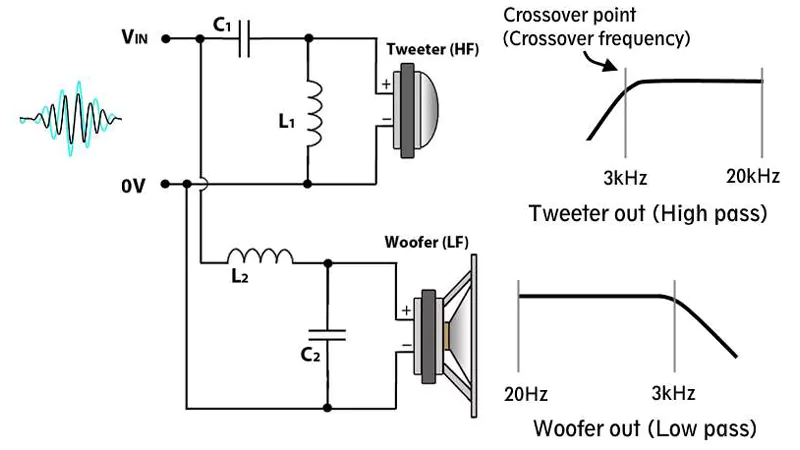
Capacitors are also employed for speaker protection. By filtering out damaging frequencies, they protect the drivers from signals that could potentially harm them. Additionally, capacitors play a role in increasing the bass response, enhancing the depth and fullness of low-end sounds in the audio output. For audiophiles and engineers alike, understanding the role of capacitors in speaker systems is critical for achieving optimal sound quality and performance.
Types of Speaker Capacitors
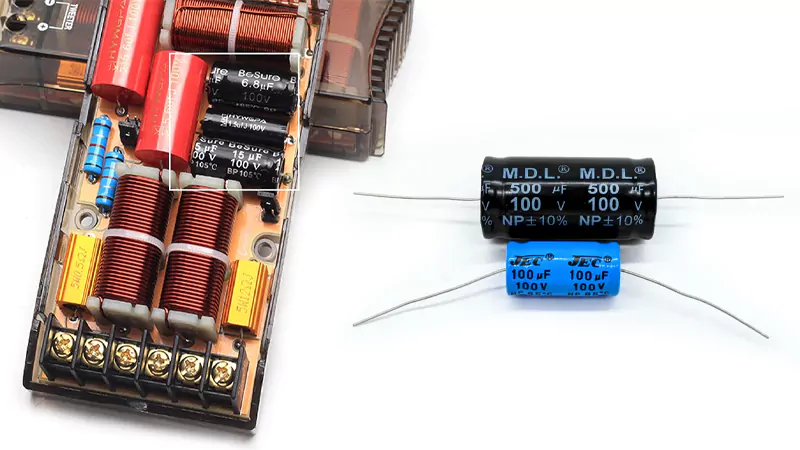
The type of capacitor used in a speaker crossover can have a significant impact on sound quality and system performance. Different types of capacitors possess distinct characteristics, making them more suitable for specific applications. Here are the main types of capacitors used in speaker systems:
Electrolytic Speaker Capacitors
Electrolytic capacitors are among the most common types used in speaker crossovers, primarily due to their cost-effectiveness. They are ideal for low-pass filters, especially when large capacitance values are required. Electrolytic capacitors are polarized, meaning they must be connected with the correct polarity, otherwise they may fail. They are typically used for woofer applications, where large capacitance values are necessary to filter out high-frequency signals from the low-end driver.
However, one of the drawbacks of electrolytic capacitors is that they tend to have a higher level of distortion compared to other types of capacitors. Over time, electrolytic capacitors can degrade and lose their effectiveness, which is why they are often replaced in older speaker systems.
Film Speaker Capacitors (Fim and Foi Capacitors)
Film capacitors, including fim and foi capacitors, are often preferred for higher-end speaker systems due to their superior performance and lower distortion levels. These capacitors are non-polarized and made from materials such as polyester, polypropylene, or other dielectric films. They have a long lifespan and tend to offer more consistent capacitance over time compared to electrolytics.
Film capacitors are often used in midrange and high-frequency drivers, where clarity and accuracy are critical. They are also commonly used in the capacitor speaker crossover of high-end speakers, where their ability to maintain signal integrity is crucial.
Ceramic Speaker Capacitors
Ceramic capacitors are compact, affordable, and widely used in many electronic applications. In speakers, they are typically found in smaller capacitance values and are more commonly used for high-frequency applications. They have relatively high tolerance levels and are less ideal for high-end audio applications because they may introduce unwanted distortion. However, they are still effective for certain low-cost or basic speaker systems.
Polyester, Polypropylene, and Mylar Speaker Capacitors
These types of capacitors fall under the category of film capacitors, and they each have specific advantages depending on the application:
- Polyester Capacitors: Often used in budget-friendly speakers. They offer a decent level of performance, but not the best in terms of clarity and precision.
- Polypropylene Capacitors: Known for their excellent performance in speaker crossover capacitors. They have low distortion, good temperature stability, and are highly effective for handling midrange frequencies.
- Mylar Capacitors: Similar to polyester capacitors but with a slightly better performance profile. They are ideal for budget-conscious audiophiles seeking good performance at a lower price point.
Capacitor Functions in Speaker Systems
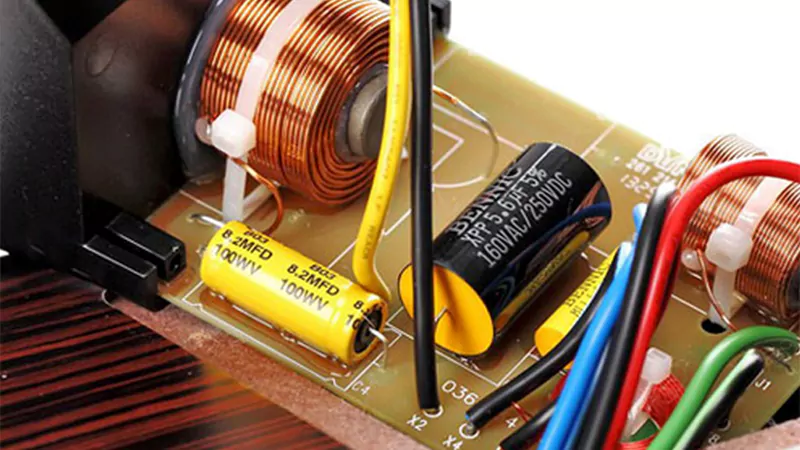
Capacitors are an essential component of speaker crossover networks, where they work in conjunction with other components like inductors to filter frequencies and ensure that each driver receives the appropriate signal. The main functions of capacitors in speaker systems include frequency filtering, protection, and enhancing overall sound quality.
Capacitors in Speaker Crossovers
In a speaker system, the capacitor speaker crossover serves as the frequency-dividing network that directs high and low frequencies to their respective drivers. Capacitors are primarily used in high-pass filters to block low-frequency signals from reaching the tweeter and in low-pass filters to block high-frequency signals from reaching the woofer. These filters allow each speaker driver to focus on its designated frequency range, preventing distortion and improving sound clarity.
- High-Pass Filters: These filters, which use capacitors, allow high frequencies to pass through while blocking low frequencies. This is crucial for protecting tweeters, as they are not designed to handle bass or midrange frequencies. For example, a midrange speaker capacitor might be used in the crossover to ensure that only the appropriate frequencies reach the midrange driver.
- Low-Pass Filters: On the other hand, capacitor speaker crossovers are also employed in low-pass filters to ensure that only low-frequency signals are passed through to the woofer. The capacitors for speaker crossovers in this case will prevent higher frequencies from distorting the sound produced by the woofer.
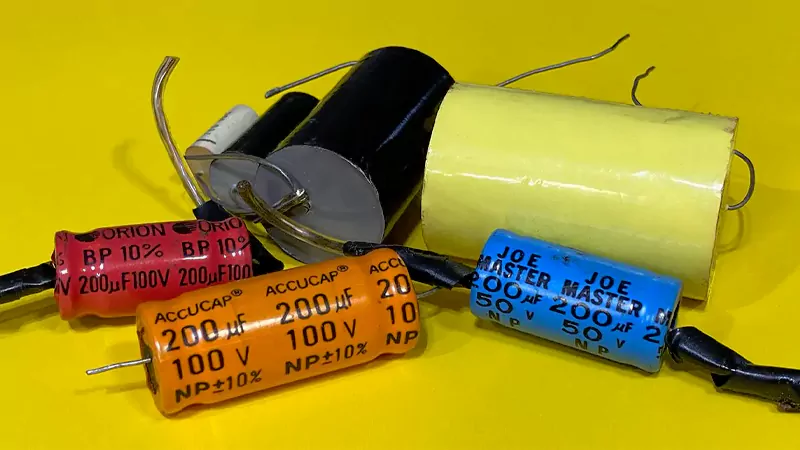
Capacitors for Speaker Protection
Another key role of capacitors in speaker systems is speaker protection. Capacitors help protect the speaker drivers from potentially damaging signals, such as high frequencies that could burn out a tweeter or over-exertion of low frequencies that could damage a woofer. Capacitors act as a buffer, ensuring that the electrical signals sent to the speakers are within safe and optimal ranges.
By implementing the capacitor across speaker terminals, this protection becomes more efficient, preventing harmful frequencies from being sent to any part of the system. This feature is especially important in passive speakers and ensures long-term durability and protection of speaker components.
Increasing Speaker Bass Using Capacitors
Capacitors can also play a role in enhancing speaker bass response. By adjusting the capacitor’s value and applying it in the crossover network, audiophiles can increase the bass output of their system. This is often done by changing the value of the speaker bass capacitor, which filters low frequencies to the woofer. By carefully selecting the appropriate capacitance, it’s possible to optimize the bass response and improve the overall audio experience.
The use of capacitors in speaker systems isn’t limited to their filtering capabilities. They help shape the overall sound output, ensuring that the frequency response is balanced and each driver operates within its optimal range, ultimately resulting in better sound quality.
Applications and Benefits of Speaker Capacitors
Capacitors in speaker systems are not only essential for basic frequency filtering but also offer a range of other benefits that enhance overall sound quality and speaker protection. Let’s explore the various applications of capacitors in speakers and the advantages they bring to audio systems.
How to Increase Speaker Bass Using Capacitors
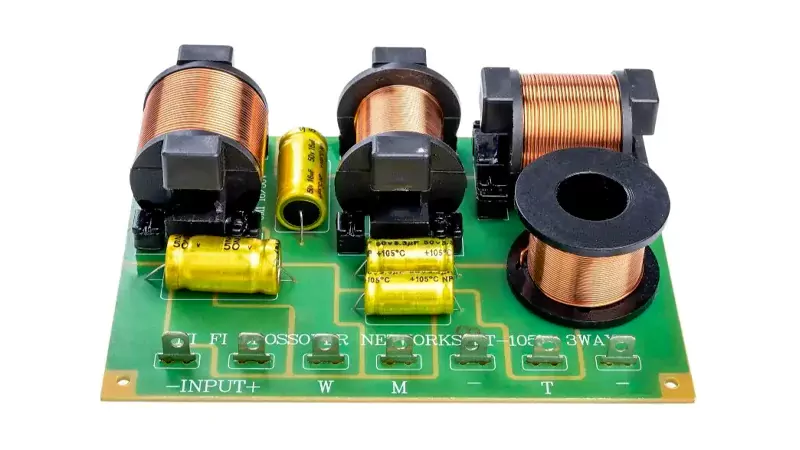
One of the most notable ways capacitors can affect speaker performance is in increasing speaker bass response. Capacitors, when used in the right crossover configuration, can help enhance low-frequency signals delivered to the woofer. The speaker bass capacitor specifically serves to tune the low-pass filter, adjusting the cutoff frequency so that more of the bass is sent to the woofer and less of the midrange and high frequencies reach it.
By choosing the right capacitor for speaker crossovers, particularly one that matches the desired crossover frequency, audiophiles can increase the richness and depth of bass reproduction. This process helps ensure that woofers are able to handle the necessary low-end frequencies without being overwhelmed by higher frequencies, leading to a cleaner and more powerful bass response.
Capacitors for Speaker Protection
Capacitors also serve as an important protection mechanism for speaker drivers. High-powered amplifiers and distorted signals can sometimes push unwanted frequencies into a speaker driver, potentially causing damage or distortion. Capacitors in the crossover network block these dangerous frequencies, acting as a buffer to protect sensitive components such as tweeters and woofers. The ability to filter out harmful signals ensures longevity and consistent performance.
In addition, capacitors contribute to the overall durability of speakers by preventing excessive heat buildup from unfiltered current. By using capacitors across speaker terminals, these protections are integrated directly into the speaker system, improving reliability and maintaining optimal audio quality over time.
Best Capacitors for Speaker Crossovers
When selecting the best capacitors for speaker crossovers, it’s important to consider the type of speaker system, the desired sound quality, and the frequency ranges each driver needs to handle. For high-end audio systems, film capacitors such as polypropylene are often considered the best choice, thanks to their low distortion and stable performance over time. For lower-cost systems, electrolytic capacitors can provide good performance at a lower price, especially for woofer applications where larger capacitance values are needed.
Overall, the best speaker capacitors are those that balance performance, durability, and the specific needs of each speaker driver, ensuring that the frequency ranges are handled accurately, resulting in optimal sound quality.
Replacing Capacitors in Speaker Crossovers
Over time, the performance of capacitors can degrade, especially if they are exposed to high temperatures or electrical stress. This is why replacing capacitors in speaker crossovers is often a necessary part of maintaining or upgrading an audio system. If a capacitor becomes weak or fails, it can lead to degraded sound quality, such as muffled highs or loss of bass response.
When replacing speaker capacitors, it’s essential to choose capacitors with similar values to the original components, unless an upgrade is planned. Additionally, replacing speaker capacitors offers an opportunity to improve sound quality by upgrading to higher-grade capacitors, such as switching from electrolytic to film capacitors, which can enhance the overall clarity and detail of the sound.
Speaker Capacitor Calculations & Charts
Choosing the right capacitors for a speaker system isn’t just about picking any capacitor—it requires precise calculations and understanding of the system’s specific needs. Here, we’ll walk through how to calculate the appropriate capacitance and provide some key charts for selecting capacitors.
Speaker Capacitor Calculator
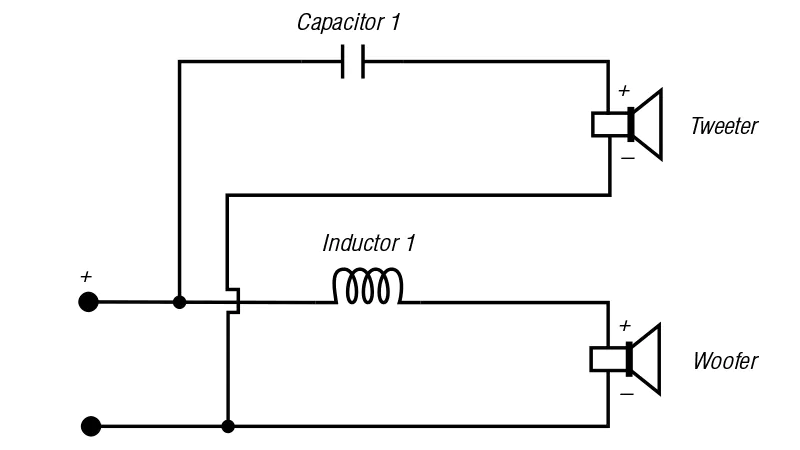
A speaker capacitor calculator is an essential tool for determining the correct capacitor value based on the desired crossover frequency. The general formula for calculating the capacitor value for a high-pass filter in a speaker system is:
C=1/2πfR
Where:
- C = Capacitor value (in Farads)
- f = Crossover frequency (in Hertz)
- R = Impedance of the speaker (in ohms)
This equation helps you find the exact capacitor for speaker crossovers that will filter the appropriate frequencies to the right driver.
Speaker Capacitor Frequency Chart
A speaker capacitor frequency chart shows the relationship between capacitance and frequency for different impedance speakers. For example, in a typical high-pass filter, the required capacitance for different speaker impedances at various frequencies can be estimated. A sample chart might look like this:
| Frequency (Hz) | 4 Ohm Impedance | 8 Ohm Impedance | 12 Ohm Impedance |
| 500 | 79 μF | 158 μF | 237 μF |
| 1000 | 39 μF | 79 μF | 118 μF |
| 2000 | 19 μF | 39 μF | 59 μF |
| 3000 | 13 μF | 27 μF | 41 μF |
Speaker Crossover Capacitor Chart
In addition to the basic capacitor frequency chart, there are specific speaker crossover capacitor charts that show recommended capacitor values for different types of crossovers (e.g., low-pass, high-pass, band-pass) and different speaker drivers. For example, a typical low-pass filter for a woofer might require a larger capacitor (e.g., 100 μF), while a high-pass filter for a tweeter might need a much smaller capacitor (e.g., 2 μF).
The specific capacitor speaker crossover chart guides users on which capacitors to use for different speaker configurations, ensuring each driver is properly filtered and the system achieves optimal performance.
Speaker Capacitor on Positive or Negative
One common question when working with capacitors in speaker systems is whether the capacitor should be placed on the positive or negative terminal of the speaker. Since most capacitors used in speaker systems are non-polarized (like film capacitors), they can be placed on either terminal. However, in some cases, such as with electrolytic capacitors, it is essential to observe the polarity, as these are polarized components. Typically, the positive leg of an electrolytic capacitor should be connected to the positive terminal of the speaker.
Replacing Speaker Capacitors
Replacing capacitors in a speaker crossover is a relatively straightforward process but requires attention to detail to ensure optimal performance. Over time, capacitors degrade due to heat, voltage fluctuations, and aging, which can lead to degraded sound quality or even complete failure. Here’s a guide on how to properly replace speaker capacitors:
Step-by-Step Guide on Replacing Capacitors
- Turn off the power: Before working with any audio equipment, make sure the power is turned off and the speaker is unplugged from any amplifier or power source.
- Open the speaker cabinet: Depending on the speaker design, you may need to remove screws or clips to access the crossover network.
- Identify the capacitors: Locate the capacitors in the crossover circuit. Check the capacitance value and voltage rating on the capacitor for replacement.
- Remove the old capacitors: Desolder the old capacitors carefully from the circuit board, ensuring not to damage any other components.
- Install the new capacitors: Place the new capacitors into the circuit, paying attention to the correct orientation if they are polarized. Solder them securely in place.
- Reassemble the speaker: Once the new capacitors are installed, reassemble the speaker and test it for sound clarity and functionality.
Speaker Capacitor Wiring
When replacing or installing capacitors in a speaker system, proper wiring is crucial for ensuring the crossover network functions correctly. Capacitor wiring involves connecting the capacitor in series with the speaker driver’s input to the crossover network, ensuring that it filters the signal as intended.
Conclusion
In conclusion, speaker capacitors are essential components in ensuring that audio systems deliver optimal sound quality and performance. From their role in speaker crossovers to enhancing bass response and protecting drivers, capacitors are integral to the function of any high-quality speaker system. Whether you are designing a new speaker setup or upgrading an older system, understanding the different types of capacitors, how to calculate and select the appropriate values, and how to replace aging components will ensure the longevity and audio fidelity of your speakers.
By choosing the best capacitors for speaker crossovers and regularly maintaining your system, you can ensure that your speakers will deliver accurate and dynamic sound for years to come. Whether you’re an audiophile, a sound engineer, or a hobbyist, understanding the technical aspects of speaker capacitors is key to unlocking the full potential of your audio system.